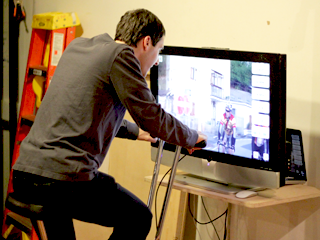Courtney Mitchell
Glute-o-licious
Glute-o-licious is a virtual cycling experience in which the user controls the speed of a first-person video by riding a stationary bike.
http://itp.nyu.edu/~cm2877/sinatra/glute_o_licious; http://courtney-mitchell.com/blog

Classes
Comm Lab: Web,Introduction to Computational Media,Introduction to Physical Computing
Comm Lab: Web,Introduction to Computational Media,Introduction to Physical Computing
Glute-o-licious is a "virtual" ride for indoor cycling. As you cycle, a first-person video of an awesome cycling course plays on a big monitor in front of you. The speed of the video playback is controlled by the speed at which you pedal! Workout data is displayed in realtime as you ride and uploaded to the glute-o-licious website for later viewing.
Background
The goal was to make a product that would be enjoyable to both the beginner fitness enthusiast and also the more serious athlete. The video makes cycling indoors more exciting, and also prompts the user to cycle faster in order to see what's ahead, just like you would if you were really outside riding a bike. I did a lot of research into what kinds of first-person cycling videos are out there already. I also took a look at different indoor bikes and bicycle computers to get very familiar with both the typical user-interface and the types of data users are used to viewing as they exercise.
Audience
Anyone tall enough to ride a bike! Primary users would likely be both gym-goers and people who exercise at home. The goal was to make a product that would be enjoyable to both the beginner fitness enthusiast and also the more serious athlete.
User Scenario
Get on the bike and start pedaling! The faster you pedal, the faster the video plays. You can listen to music through the application with the built in music player. When finished, your workout data is graphed and displayed on the screen, and, if you enter your name and email address, the data is also sent to the website where you can see your workout results and compare with others.
Implementation
Glute-o-licious is comprised of a physical component and a software component. The physical component consists of a stationary bike equipped with two two magnetic reed switches connected to an Arduino, two magnets (they trigger the switches), a monitor, a wireless mouse (in an ideal world, the monitor would be a touch-screen monitor eliminating the need for a mouse), keyboard, and some speakers. The application is written in processing and includes video, music, and image files.
Conclusion
Glute-o-licious drew on things I learned in ever class I have taken at ITP thus far: Video/Sound, 2D Design, Web, Physical Computing, and ICM. Through user testing I learned a lot about how people want to and/or expect to interact with glute-o-licious and got a taste of what product development is like. Most importantly, I discovered that a lot of people are really EXCITED about glute-o-licious!
Background
The goal was to make a product that would be enjoyable to both the beginner fitness enthusiast and also the more serious athlete. The video makes cycling indoors more exciting, and also prompts the user to cycle faster in order to see what's ahead, just like you would if you were really outside riding a bike. I did a lot of research into what kinds of first-person cycling videos are out there already. I also took a look at different indoor bikes and bicycle computers to get very familiar with both the typical user-interface and the types of data users are used to viewing as they exercise.
Audience
Anyone tall enough to ride a bike! Primary users would likely be both gym-goers and people who exercise at home. The goal was to make a product that would be enjoyable to both the beginner fitness enthusiast and also the more serious athlete.
User Scenario
Get on the bike and start pedaling! The faster you pedal, the faster the video plays. You can listen to music through the application with the built in music player. When finished, your workout data is graphed and displayed on the screen, and, if you enter your name and email address, the data is also sent to the website where you can see your workout results and compare with others.
Implementation
Glute-o-licious is comprised of a physical component and a software component. The physical component consists of a stationary bike equipped with two two magnetic reed switches connected to an Arduino, two magnets (they trigger the switches), a monitor, a wireless mouse (in an ideal world, the monitor would be a touch-screen monitor eliminating the need for a mouse), keyboard, and some speakers. The application is written in processing and includes video, music, and image files.
Conclusion
Glute-o-licious drew on things I learned in ever class I have taken at ITP thus far: Video/Sound, 2D Design, Web, Physical Computing, and ICM. Through user testing I learned a lot about how people want to and/or expect to interact with glute-o-licious and got a taste of what product development is like. Most importantly, I discovered that a lot of people are really EXCITED about glute-o-licious!

